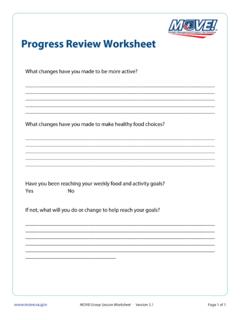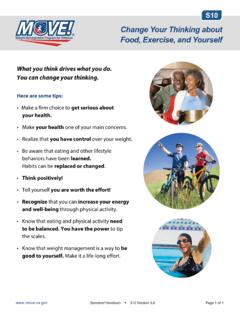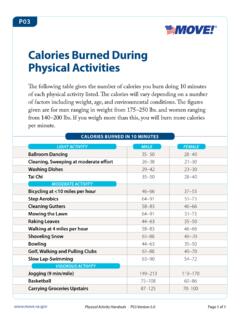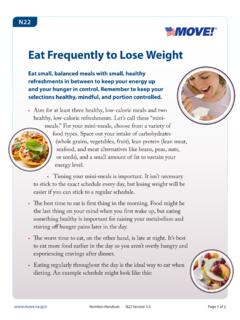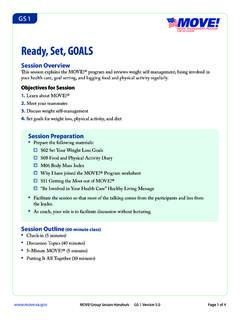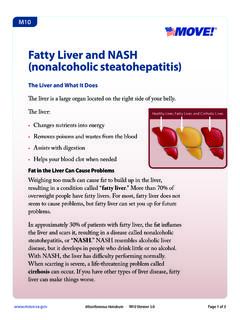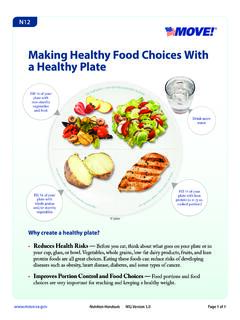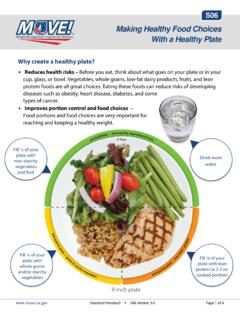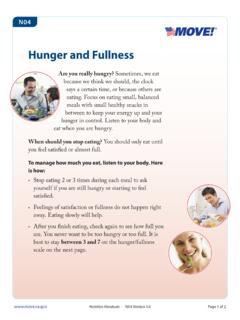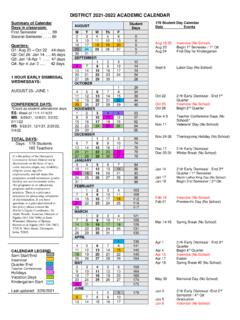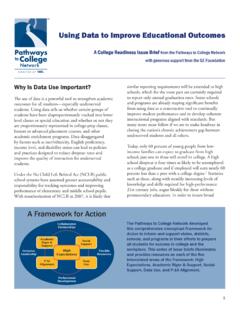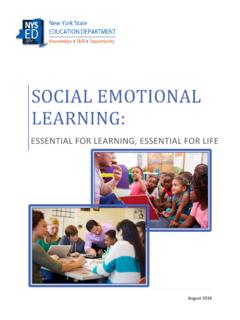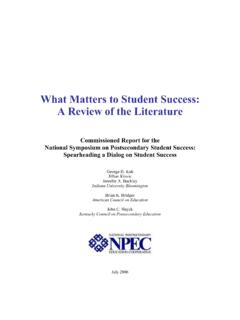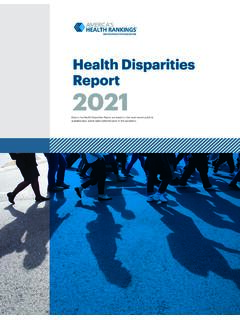Transcription of How to Write an Exercise Prescription - Veterans Affairs
1 How to Write anExercise PrescriptionMAJ Robert L. Gauer, MDLTC Francis G. O Connor, MD, FACSMD epartment of Family MedicineUniformed Services University of the Health SciencesHow to Write an ExercisePrescriptionMAJ Robert L. Gauer, MDLTC Francis G. O Connor, MD, FACSMD epartment of Family MedicineUniformed Services Universityof the Health OF FOR OF THE HEALTH CARE OF Mortality .. Vascular Disease .. Mellitus ..12 VIII. Health .. OF PHYSICAL Related Sudden .. of Physical Activity Recommendations .. Recommendations ..22A. ACSM CDC/ACSM AHA Scientific AMA Guidelines for Adolescent Preventive Department of Health and Human Services ..25F. United States Preventive Services Task Force .. of Recent Physical Activity Recommendations ..25 Exercise to Recommending Exercise .. Evaluation .. Exercise the Exercise Prescription .
2 37A. Activity Frequency ..40C. Duration ..40D. The Exercise Rate of Muscle Principles of Exercise Prescription in Secondary Prevention ..53A. Prescription in the Absence of Ischemia or Significant Prescription in the Presence of Ischemia or Arrhythmias ..54C. Summary .. Mellitus ..57A. Exercise in Type 1 Diabetes Mellitus ..57B. Exercise in Type 2 Diabetes Mellitus ..59C. Complications .. Disease ..75 VIII. Exercise in the Personnel .. - Exercise ASSESSMENT - NATIONAL CHOLESTEROL EDUCATION PROGRAM: EXPERT PANEL GUIDELINES FOR DIAGNOSIS AND TREATMENT OF HIGH - EFFECTS OF MEDICATIONS ON HEART RATE, BLOOD PRESSURE, AND Exercise CAPACITY ..C-1D - CARDIOVASCULAR Prescription - BEGINNER S PROGRAM TRAINING LOG ..E-1F - INTERMEDIATE PROGRAM TRAINING - BODY MASS INDEX TABLE ..G-1 RESOURCES/REFERENCESI ndividual Guidelines for Cardiovascular Guidelines for Patients with Diabetes Mellitus.
3 REF-5 Exercise Guidelines for Pregnancy and Post-partum ..REF-7 Weight Training Guidelines for Healthy Adults and Low-Risk Cardiac Patients ..REF-9iiiRESOURCES/REFERENCES (continued)PageAquatic Exercise Workout .. REF-11 Training for the Army Physical Fitness Test (APFT) .. REF-13 Getting Out of Your Chair .. REF-15 How to Start a Walking Program .. REF-17 Exercising in Cold Weather .. REF-19 Sensible REF-21 Fitness injury prevention .. REF-23 Conditioning Exercises .. REF-25 Bend and Stretch .. REF-27 National REF-31 Figures1. Exercise Assessment and Prescription Flow Cardiovascular Risk Assessment ..353. Management of Exercise Induced 1. PROPORTION OF ADULTS REPORTING NO LEISURE-TIME ACTIVITY WITHIN THE LAST MONTH, 1991 BEHAVIORAL RISK FACTOR SURVEILLANCE SYSTEM ..4 TABLE 2. BARRIERS AND MOTIVATORS ASSOCIATED WITH PHYSICAL 3.
4 PHYSICAL ACTIVITY AND THE REDUCED RISK OF SPECIFIC CANCERS ..10 TABLE 4. PRETEST PROBABILITY OF CORONARY ARTERY DISEASE BY AGE, GENDER, AND SYMPTOMS ..17 TABLE 5. CATEGORIES OF ACTIVITY BY MUSCULOSKELETAL IMPACT ..19 TABLE 6. EXAMPLES OF COMMON PHYSICAL ACTIVITIES FOR HEALTHY US ADULTS BY INTENSITY OF EFFORT REQUIRED ..24 TABLE 7. HOW TO APPROACH ROADBLOCKS ..29 TABLE 8. MODEL FOR PHYSICAL ACTIVITY 9. PRE- Exercise EVALUATION HISTORY ..31 TABLE 10. CONTRAINDICATIONS TO 11. INDICATIONS FOR Exercise STRESS TESTING ..33 TABLE 12. COMPONENTS OF AN Exercise Prescription ..37 TABLE 13. ACTIVITY SELECTION GUIDE ..38 TABLE 14. ENERGY EXPENDITURES FOR VARIOUS ACTIVITIES ..39 TABLE 15. BORG SCALE FOR RATING PERCEIVED EXERTION ..43ivTABLES (continued)PageTABLE 16. CLASSIFICATION OF PHYSICAL ACTIVITY INTENSITY, BASED ON ACTIVITY LASTING UP TO 60 17.
5 PROGNOSTIC FACTORS FOR PATIENTS WITH CORONARY ARTERY DISEASE ..49 TABLE 18. NEW YORK HEART ASSOCIATION FUNCTIONAL CLASSIFICATION FOR CONGESTIVE HEART FAILURE ..50 TABLE 19. PREVENTION OF HYPOGLYCEMIA OR 20. Exercise AND THE STRESS ACROSS SELECTED 21. Exercise GUIDELINES FOR PREGNANCY AND THE POSTPARTUM PERIOD ..64 TABLE 22. FACTORS THAT SUGGEST Exercise -INDUCED ASTHMA ..68 TABLE 23. COMPONENTS OF THE COPD Exercise 24. CLASSIFICATION OF OVERWEIGHT AND OBESITY BY BMI AND ASSOCIATED DISEASE RISK ..75 TABLE 25. FUNCTIONAL CHANGES ASSOCIATED WITH 26. GENERAL GUIDELINES FOR THE Exercise Prescription IN CHRONICALLY ILL PATIENTS ..821 INTRODUCTION All parts of the body if used in moderation and exercised in labors towhich each is accustomed, become thereby healthy and well developed,and age slowly; but if unused and left idle, they become liable to disease,defective in growth, and age quickly.
6 HippocratesRegular physical activity has been regarded as an important component of a healthy lifestyle and hasbeen proven to increase longevity and the overall quality of Recently, this stand has been reinforcedby scientific data linking physical activity to a wide array of physical and mental health ,3 Despite this evidence and the apparent heightened public awareness, millions of Americans continue topractice sedentary lifestyles. In order to effect change, it is very important that health care providers(HCPs) include Exercise counseling as a part of routine health maintenance. HCPs in this paper refers tophysicians, physicians assistants, nurse practitioners and those directly involved in primary health need to emphasize the benefits of Exercise and encourage all children and adults to engage in atleast 20 to 60 minutes of formal physical activity at a minimum of 3 days per week.
7 Most patients canbegin a formal Exercise Prescription program after consultation with a HCP. Selected high-risk patients,specifically those with pre-existing coronary artery disease (CAD), may require further evaluation priorto initiation of Exercise . Specific instruction should be given to the patient as to type, frequency,intensity and duration of Exercise . This is most readily achieved through a written Exercise prescriptionprogram. The products of an effective Exercise program are disease prevention, healthy living and ageneral sense of well being. This monograph is designed to assist HCPs in appropriately prescribing Exercise to their patients. Thisdocument will review specific benefits of Exercise , risks associated with Exercise , currentrecommendations on Exercise , cardiovascular risk assessments, assessing an individual s desire tobecome physical fit, and guidelines for writing an Exercise Prescription .
8 Information is provided onexercise precautions for individuals with specific health issues such as heart disease, diabetes mellitus,lung disease and pregnancy. Included are convenient references that are available to patients in the formof handouts. The intent of this paper is to instill confidence in prescribing Exercise to a broad patientpopulation, thus mastering the art of Exercise Prescription . 2 3 EPIDEMIOLOGY OF INACTIVITY The 1991 National Health Interview Survey-Health Promotion/Disease Prevention reported that 22% ofadults engage in light to moderate physical activity for at least 30 minutes per day, 54% are somewhatactive, but do not meet the current recommendations, while 24% are completely sedentary (reporting nophysical activity over the past month).4 Patterns of physical activity vary with demographic characteristics (Table 1).
9 Women reported higheramounts of inactivity than did men. Variations in race/ethnicity were significant as well, demonstratingthat African Americans and other ethnic minority populations are less active than white Theprevalence of inactivity, in general, increases with age. There does, however, appear to be a slightincrease in physical activity in adults over 65 years of age, but overall, physical activity declines withadvancing Individuals with a college education are almost twice as likely to be active compared toindividuals with a high school level education. As with education, socioeconomic patterns are similar. Individuals with an annual income of less than$15,000 per year are twice as likely to be sedentary compared to adults who makes in excess of $50,000per year. Differences in education and socioeconomic status account for most, if not all of thedifferences in leisure-time physical activity associated with race and Among youths, 60% ofmales and 47% of females reported participating in vigorous activity of three or more times per Assessing population attributable risk is one way to demonstrate the impact of inactivity on on 1992 estimates, 35% of the deaths from CAD are attributed to physical , an estimated 168,000 of the 480,000 CAD deaths would not have occurred if everyone wereoptimally Based on Healthy People 2000 objectives, if 30% of the population were to engage inregular Exercise , defined as 30 minutes of light to moderate Exercise , preferably daily, approximately24.
10 000 deaths from CAD per year would be Epidemiology of Inactivity4 Table 1 Proportion of Adults Reporting No Leisure-Time Activity Within The Last Month, 1991 Behavioral Risk Factor Surveillance SystemDemographic GroupSedentary, % (95% CI) Sex ( ) ( ) Race ( ) ( ) Age, years ( ) ( ) > ( ) Annual income, $ <14, ( ) 15,000-24, ( ) 25,000-50, ( ) >50, ( ) Education Some high ( ) High school /tech school ( ) Some college/college ( )A population-based random-digit-dial-telephone survey with 87,433 respondents aged 18 years and older from 47 states and the District ofColumbia. Data are weighted, and point estimates and confidence intervals (CI s) are calculated using the SESUDAAN procedure to adjust forthe complex sampling , it has been estimated that 250,000 deaths per year in the United States, approximately 12%of the total mortality, are associated with a sedentary The benefit of Exercise has beendemonstrated in both primary (no evidence of disease) and secondary (diagnosed disease) preventionstrategies.
